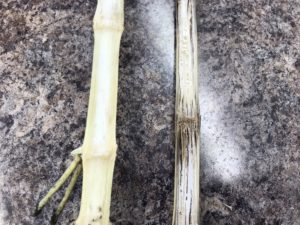
Be Prepared For Potential Stalk Rots in Corn This Fall
Throughout the 2019 growing season, growers have faced significance issues from many different directions.
Unfortunately we need to be prepared for yet another one: stalk rots in corn.
What can lead to stalk rots?
Stalk rot pathogens, such as Anthracnose and Fusarium, are always present in the environment but need certain weather and host conditions to become a widespread problem. The prolong period of wet weather that the Upper Midwest has faced in recent months is favorable for stalk infection by a variety of plant pathogens. The wet weather also favors infection because it has led to many fields being overly stressed due to a lack/loss of nitrogen, compromised root systems due to sidewall compaction, lack of tillage to bury inoculum in past residue, and general failure to thrive due to saturated conditions. Plants affected by these stressors are more likely to have weak stalks already and are much more susceptible to infection. Some hybrids may also be more genetically susceptible to certain diseases as well. Before harvest begins, work with your seed representatives to highlight fields that may have one or more of these risk factors and scout for stalk rots infields that you identify.
How do we scout for stalk rots?
Scout regularly and use the PUSH or PINCH tests to indicate stalk issues. For PUSH – Push the plant tops away from you at a 30 degree angle. If they don’t return to vertical or they snap, they may be compromised by a stalk rot. For the PINCH test – Pinch the lower internodes of the plant. If they are crushed easily by your hand their integrity has been compromised. If 10% or more plants fail these tests consider harvesting the field early to reduce possible losses.
Identify the Pathogen
It is important to correctly identify the pathogen if you believe a field to be compromised by stalk rot. You will be able to see the differences in how the pathogens present themselves easiest by cutting the stalk open. Your Jacobsen Seed Representative can help you identify these diseases as well. By knowing the pathogen you can correctly choose a management plan for future corn crops. Some stalk rots, such as anthracnose, can be controlled by hybrid tolerance. Others do not have genetic tolerance and can be controlled by general cultural practices.
What can be done to manage stalk rots in the future?
- Have good documentation. It can be tough to remember all the little details so make sure to document areas of concern thoroughly and clearly. This will help when planning for the next corn crop.
- Reduce corn stalk residue by rotating to a non-host crop or by using tillage to bury residue. Both foliar and stalk diseases can over winter in the residue leading to higher pressure next season. This is especially important in continuous corn or no-till operations.
- Choose a more tolerant hybrid next time the field is in corn production. Jacobsen Seed hybrids come with disease, stalk, and stress ratings which can be put together with the help of your seed adviser to give you a better fitting hybrid on your farm.
- Make sure to keep up fertility! Correct soil fertility is the first step towards a healthy plant. Use soil tests to understand your current levels and fertilize accordingly.
- Manage crop stresses. This is easier said than done but things like over population, poor spacing, and compaction can lead to plant stress. When a plant is stressed it is less likely to be able to defend itself from plant pathogens.
- Control insects. Corn borer and other insects can leave wounds that open the plant up to disease. Jacobsen Seed offers a wide variety of trait packages for insect control.
